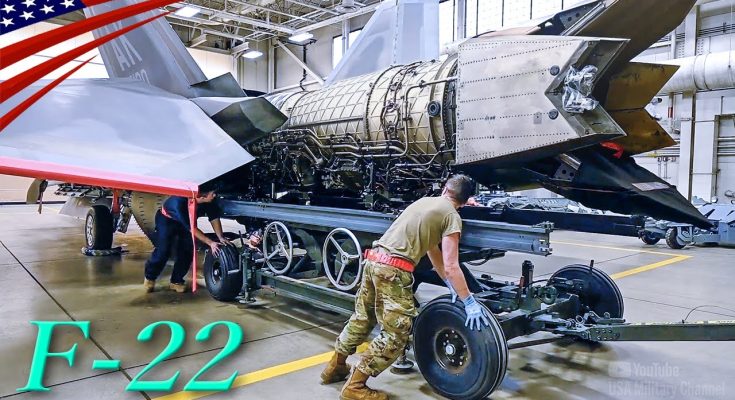The F-22 Raptor is a technological marvel, representing the cutting edge of modern stealth fighter design. Developed by Lockheed Martin for the United States Air Force, it is widely regarded as the world’s most advanced fighter jet. Known for its unmatched combination of stealth, speed, agility, and advanced avionics, the F-22 has cemented its place as a vital asset for air superiority missions. However, beyond its capabilities in the sky, the maintenance and engine performance of the F-22 also highlight its intricate engineering, particularly when it comes to tasks such as engine removal and full afterburner tests.
F-22 Raptor Engine Removal: A Complex Procedure
The F-22’s engine, the Pratt & Whitney F119-PW-100, is a key component in giving the aircraft its remarkable performance. This turbojet engine not only powers the jet at speeds exceeding Mach 2, but it also enables supercruise—the ability to fly at supersonic speeds without the need for afterburners. Removing and replacing this engine is a complex and delicate procedure that requires precise planning, skilled technicians, and a deep understanding of the aircraft’s sophisticated systems.
Engine removal is typically conducted during maintenance operations, such as scheduled overhauls or if the engine requires servicing due to wear or damage. The process starts with the disconnection of the fuel and electrical systems that power the engine, followed by the removal of external components, such as the engine cover and air ducts. Once the engine is sufficiently exposed, the technicians carefully unbolt the engine mounts, which secure the engine to the airframe, and use specialized lifting equipment to remove the engine from the fuselage. Due to the engine’s weight and the delicate nature of the surrounding systems, this operation is carried out with extreme caution.
Full Afterburner Test in Action: Demonstrating Power
The afterburner is a critical component of the F-22’s engine, enabling it to achieve the extraordinary speeds and performance levels required for air superiority missions. Afterburners work by injecting additional fuel into the exhaust stream of the engine, igniting it to create an enormous thrust increase, all while producing the characteristic bright flame plume visible during high-speed maneuvers.
When conducting a full afterburner test, the goal is to ensure that the engine can perform at its peak power and efficiency. This test is typically conducted on the ground or during a flight test to assess the engine’s performance after maintenance or an engine swap.
During the test, the F-22 pilot pushes the throttle forward to engage the afterburner, and the jet enters afterburner mode. This results in a massive increase in thrust, typically producing around 35,000 pounds of thrust or more. As the afterburner ignites the extra fuel, a dazzling blue or orange flame erupts from the engine’s tailpipe. This test not only demonstrates the F-22’s power but also ensures that the afterburner is functioning correctly, providing the extra thrust needed for rapid acceleration or high-speed interception missions.
Combining Stealth and Power
The F-22 Raptor’s design makes it unique in terms of performance, particularly in terms of low observability (stealth) and power. With the removal and installation of the engine, the aircraft can be fine-tuned to maintain its combat readiness. The full afterburner test, on the other hand, gives a thrilling showcase of the aircraft’s true potential, providing the thrust-to-weight ratio needed for super-fast response times in aerial combat.
The combination of powerful engines, stealth features, and cutting-edge avionics allows the F-22 to dominate the skies, with capabilities far beyond those of most other aircraft. From the maintenance procedures like engine removal to testing its full afterburner performance, the F-22 Raptor is an unparalleled machine in terms of both complexity and sheer power.
In conclusion, the F-22 Raptor’s engine removal and afterburner tests provide a deeper look into the inner workings of a fighter jet that is as lethal as it is sophisticated. These procedures underscore the incredible engineering that allows the aircraft to maintain its status as the world’s most advanced fighter, capable of executing missions with unmatched precision and power.



